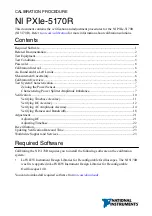
1.
Connect the SMA (m)-to-BNC (f) adapter to channel 0 of the NI 5170R.
2.
Connect the calibrator test head to the SMA (m)-to-BNC (f) adapter.
3.
Configure the NI 5170R with the following settings:
•
Bandwidth: Full Bandwidth
•
Vertical range: 1 V
pk-pk
•
Sample rate: 250 MS/s
•
Number of samples: 1,048,576 samples
4.
Configure the calibrator and generate a waveform with the following characteristics:
•
Waveform: Sine wave
•
Amplitude: 0.9 V
pk-pk
•
Frequency: 11 MHz
•
Load impedance: 50 Ω
5.
Enable the calibrator output.
6.
Wait 1 second for settling, then measure and record the peak frequency using the Extract
Single Tone Information VI.
7.
Calculate the timebase error using the following formula:
Timebase error
= (
F
measured
- (11 × 10
6
))/11
8.
Compare the timebase error to the appropriate limit from the
Timebase Accuracy
Verification
table.
Note
Timebase verification is only required on one channel.
Verifying DC Accuracy
Follow this procedure to verify the DC accuracy of the NI 5170R by comparing the voltage
measured by the NI 5170R to the value sourced by the voltage standard.
Refer to the following table as you complete the following steps:
1
Measurement uncertainty based on Fluke 9500B with Fluke 9530 test head specifications that
apply at T
cal
±5 °C, where Factory T
cal
= 23 °C. Uncertainty of the 9500B includes long-term
stability of 1 year (5 years for frequency), temperature coefficient, linearity, load, and line
regulation and traceability of factory and National Calibration Standard.
2
Measurement uncertainty based on Fluke 9500B with Fluke 9530 test head specifications that
apply at T
cal
±5 °C, where Factory T
cal
= 23 °C. Uncertainty of the 9500B includes long-term
stability of 1 year (5 years for frequency), temperature coefficient, linearity, load, and line
regulation and traceability of factory and National Calibration Standard.
12
|
ni.com
|
NI PXIe-5170R Calibration Procedure
























